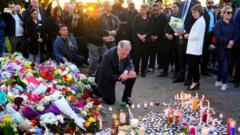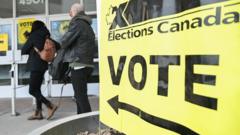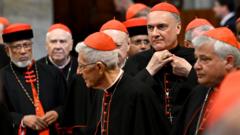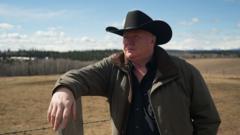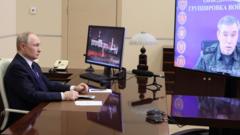A fascinating transformation unfolded in Canada's electoral landscape as the leading parties prepare for a pivotal showdown.
**Canada's Election: An Intense Race Amidst Changing Political Tides**
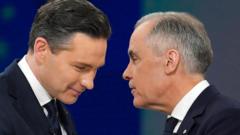
**Canada's Election: An Intense Race Amidst Changing Political Tides**
As voters head to the polls, the stakes rise in a tumultuous election season.
At a vibrant rally in Vaughan, Ontario, Mark Carney, the Liberal party leader, faced a fired-up crowd expressing defiance against the looming influence of America. “President Trump is poised to undermine us for his own gain,” Carney warned, only to be met with chants of “Never!” from supporters waving Canadian flags cheerfully attached to hockey sticks. This fervor mirrors the enthusiasm seen when Conservative leader Pierre Poilievre engaged supporters in Toronto, rallying under the banner of “Bring it Home” amid rising Canadian nationalism amidst U.S. economic threats.
In this decisive last stretch of the campaign, the memory of Donald Trump casts a long shadow; the party that articulates a comprehensive strategy to counter his administration’s threats seems poised for victory. National polling indicates that the Liberals have clung to a slight advantage as the campaign draws to a conclusion. However, Trump is not the sole variable at play; Poilievre has opted to focus on disgruntled voters unhappy with what he dubs a “Lost Liberal decade,” voicing criticisms of the existing government’s failure on housing, crime, and the opioid crisis.
Voter sentiments resonate strongly with constituents like Eric and Carri Gionet, from Barrie, Ontario. This couple, who possess well-established financial stability, are jarred by the stark contrast in opportunities available to their daughters. “Back in our day, we bought our first house young, but that prospect feels remote for them,” lamented Eric. “I’m hopeful,” remarked Carri, reflecting the duality of aspirations and uncertainty in the electorate.
The situation seemed bleak for the Liberals just a year ago; they trailed significantly in polls behind the Conservatives. However, a seismic shift occurred with the resignation of Justin Trudeau and Carney's ascension as the new Liberal leader. Following an abrupt return of Trump to the presidency, with aggressive tariff threats, the political landscape shifted dramatically, leading to a competitive race by late March.
The Liberals, once on the verge of a complete political collapse, are now energized by the belief that they might capture their fourth straight victory, possibly even gaining a majority in Parliament. Carney positions himself as the resilient candidate, utilizing his past experience as a central banker during financial crises to reassure voters.
While many see Carney's rise as an impressive feat, others, like Gwendolyn Slover, question whether one figure can change the narrative. “They worship him like some kind of savior,” she remarked skeptically, observing that he is merely part of the same party.
On the other hand, Poilievre’s seasoned political experience faces challenges in resonating deeply amid shifting dynamics, as his “Canada First” stance tries to establish a distinct identity from Trump’s approach despite being labeled as “Trump lite” during the campaign.
The political landscape of this election showcases a rigid divide between historic party affiliations and the growing influence of smaller entities like the NDP and Bloc Québécois. While both smaller parties risk reallocating their seats, many voters are increasingly gravitating towards the two main party candidates. Simultaneously, a rare scenario could emerge if both frontrunners secure over 38% of the national vote share, something unseen since 1975.
Jagmeet Singh, leader of the NDP, emphasized the necessity for strategic voting, encouraging constituents to weigh the importance of either Carney’s potential supermajority or the strength of the New Democrats as a counterbalance when casting their ballots.
During the campaign, vital issues—such as climate change, immigration, and reconciliation efforts—took a backseat to the pressing discussions surrounding the U.S.-Canada relationship and economic security. Both Carney and Poilievre broadly agree on priorities, including diminishing reliance on the U.S. economy and expanding the development of oil, gas, and mining sectors. Yet the crux of the debate lies in discerning which leader can guide Canada amidst uncertainty and economic peril.
“It’s time for tested experience, not risky trials,” Carney adamantly stated before his supporters, while Poilievre countered with an impassioned call to action, asserting, “We can determine our fate and regain control over our future this coming Monday.”


